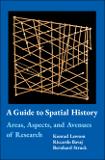A guide to spatial history : areas, aspects, and avenues of research
Abstract
This guide provides an overview of the thematic areas, analytical aspects, and avenues of research which, together, form a broader conversation around doing spatial history. Spatial history is not a field with clearly delineated boundaries. For the most part, it lacks a distinct, unambiguous scholarly identity. It can only be thought of in relation to other, typically more established fields. Indeed, one of the most valuable utilities of spatial history is its capacity to facilitate conversations across those fields. Consequently, it must be discussed in relation to a variety of historiographical contexts. Each of these have their own intellectual genealogies, institutional settings, and conceptual path dependencies. With this in mind, this guide surveys the following areas: territoriality, infrastructure, and borders; nature, environment, and landscape; city and home; social space and political protest; spaces of knowledge; spatial imaginaries; cartographic representations; and historical GIS research.
Citation
Lawson , K M , Bavaj , R & Struck , B 2022 , A guide to spatial history : areas, aspects, and avenues of research . Olsokhagen Publishing , Edinburgh . < https://spatialhistory.net/guide/ >
Type
Book
Collections
Items in the St Andrews Research Repository are protected by copyright, with all rights reserved, unless otherwise indicated.

